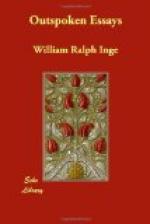It is tempting to give a concrete instance by way of illustrating the impassable chasm which divides Catholicism as a working system from the academic scheme of transformation which we have been considering.
’The French Catholics (writes the Times correspondent in Paris on June 25, 1908) are awaiting with concern the report of a special commission on a mysterious affair known as the Miraculous Hailstones of Remiremont. On Sunday, May 26, 1907, during a violent storm that swept over that region of the Vosges, among the great quantity of hailstones that fell at the time a certain number were found split in two. On the inner face of each of the halves, according to the local papers that appeared the next day, was the image of the Madonna venerated at Remiremont and known as Notre Dame du Tresor. The local Catholics regarded it as a reply to the municipal council’s veto of the procession in honour of the Virgin. So many people testified to having seen the miraculous hailstones that the bishop of Saint-Die instituted an inquiry; 107 men, women, and children were heard by the parish priest, and certain well-known men of science [names given] were consulted. The report has just been published in the Semaine Religieuse, and concludes in favour of the absolute authenticity of the fact under inquiry. ....The last word rests with the bishop, who will decide according to the conclusions of the report of the special commission.’
This is Catholicism in practice. Those who think to reform it by their contention that supernatural interventions can never be matters of fact, are liable to the reproach which they most dislike—that of scholastic intellectualism, and neglect of concrete experience.
This denial of the supernatural as a factor in the physical world seems to us alone sufficient to make the position of the Modernists in the Roman Church untenable. That form of Christianity stands or falls with belief in miracles. It has always sought to bring the divine into human life by intercalating acts of God among facts of nature. Its whole sacred literature, as we have said, is penetrated through and through by the belief that God continually intervenes to change the course of events. What would become of the cult of Mary and the saints if it were recognised that God does not so interfere, and that the saints, if criticism allows that they ever existed, can do nothing by their intercessions to avert calamity or bring blessing? The Modernist priest, it appears, can still say ‘Ora pro nobis’ to a Mary whose biography he believes to be purely mythical. At any rate, he can tell his consultants with a good conscience that if they pray to Mary for grace they will receive it. But what is the good of this make-believe? And, if it is part of a transaction in which the worshipper pays money for assistance which he believes to be miraculous and only obtainable through the good offices of the Church, is it even morally honest? The worshipper may be helped by his subjective conviction that his cheque on the treasury of merit has been honoured; but if, apart from the natural effects of suggestion, nothing has been given him but a mere placebo, is the sacerdotal office one which an honourable man would wish to fill?




